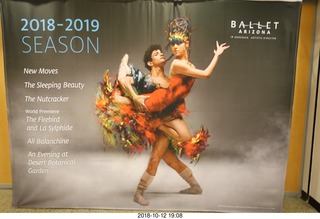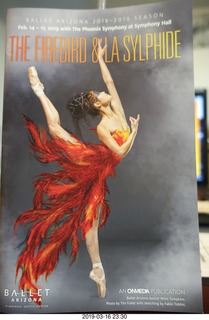
|
Ballet Arizona: The Firebird Ballet2019 February 14 |

|

|
Ballet Arizona: The Firebird Ballet2019 February 14 |

|
Who hasn't heard Igor Stravinsky's amazing piece "The Firebird Ballet," first performed 1910 June 25 in Paris? It's a stunning piece of music that I've heard in live orchestral concert halls maybe half a dozen times and it made a wonderful finale for Disney's "Fantasia 2000" movie. I've never seen it danced before this show.
When Ballet Arizona announced an aggressively-new choreography for this piece, I sat up straight and made it my business to get the best ticket I could get for opening night. Artistic Director Ib Anderson has presented old and new ballets with passion, precision, and pride. The announcement of this show was accompanied by a promotional frenzy about aggressively-new dance, a futuristic setting, a story about aliens, space costumes, and a high-tech backdrop. I've heard bragging of super-futuristic, high tech presentations before, and been disappointed before, it becomes about the technology and not the content, but never by Ballet Arizona, never by Ib Anderson, and never by these wonderful, amazing dancer-athletes who make gravity look optional.
I'm a big-enough fan of Ballet Arizona that I go to the "Studio Spotlight" previews of upcoming shows and this seemed a bigger, scarier, more innovative, more daring leap into a strange new future of ballet than I've seen before. Just in case it wasn't bold and new enough, the first part of the show was "La Sylphide" from 1836, just about the oldest ballet choreography we have in 2019.
I'd like to address why I feel some urgency to review a show that is over and done, no more "Firebird" performances. Maybe it will come back, I don't know, but not this or next season. Still, I feel a sense of urgency to say some things about it. First, there are other shows to come, I hope a lot more shows in my future, coming from Ballet Arizona and one really good show bodes well for future shows, even in the shadow of a history of excellence. Second, I want our community of ballet lovers to share a standard of excellence and we get that by communication, sometimes about successes and sometimes about failures.
Spoiler Alert: My Arizona-Ballet-Firebird experience was all about success. We learn from both success and failure. I admit it's a lot more fun learning from success as is the case here.
Let's look at some of the successes in the Firebird show.
• Choreography - This was a big, bold ballet. There were turns and twists hell and gone from the usual, especially after "La Sylphide" right before intermission. I appreciated that this far-reaching space dance kept its feet firmly planted in the tradition of ballet. I recently went to Petit Mort with the Pennsylvania Ballet in Philadelphia. It was terrific dance, but I felt, somewhere along the way, they forgot they're a ballet company. (The Aspen Sante Fe Ballet is a terrific modern-dance group that is far from actual ballet, but they're not a big-city real-ballet company and I can be more forgiving of them not doing real ballet.) Their next performance, "Giselle," was utterly delightful and totally faithful to ballet principles, so far as I could see. I never felt a moment of that discomfort from Ib Anderson's fantastic, futuristic, phenomemonal, fun moves on the stage. It was truly special. (Before the show, I saw Ib walking around nervously like things weren't going to go right, some pre-performance willies, but his work certainly went right on the stage.) During the "Studio Spotlight" preview, I remember thinking that there were a few go-wrong places where the moves were aggressive and recovery might be difficult. In particular, there was a point where several women were tossing two balls among themselves, a lot of tosses begging for a miss. They actually missed one toss and another dancer took the dropped ball and continued the scene. Earlier a ballerina on pointe fell down, she bounced back up and went on as if nothing happened, and it certainly didn't spoil my enjoyment of what I saw.
• Costumes - Fabio Toblini was hailed as a wardobe wonder and he didn't let me down. Much was made before the show of the time involved and the difficulty getting everything ready in time. I quipped that it would be ready on time out of necessity (were they going on stage naked?), but that the dress would be daringly fantastic by showtime. The space-nymph firebird was sexy and asexual at the same time, the warriors were warlike, the princesses were regal and beautiful, and the terrifying monster was terrifying and monstrous. Okay, Fabio was good, I get that. But here's the thing for me. I've seen great costumes in plays, picture Hamlet delivering his soliloquy with arm movements or even a wicked gremlin running across the stage. These costumes clothed dancers doing twists and twirls, piroettes and fouettes, leaps and bounds and they did it well.
• Plot - For the traditional "Firebird" it says here on Google, "The ballet centers on the journey of its hero, Prince Ivan. While hunting in the forest, he strays into the magical realm of Kosche the Immortal, whose immortality is preserved by keeping his soul in a magic egg hidden in a casket. ... When Koschei sends his minions after Ivan, he summons the Firebird." This ballet has a prince exploring a new planet capturing a wondrous creature, the Firebird, and the prince falling in love in a world with warrior princesses and a monster. It may have been far from the original story line, but it was intimately close to the musical score. The scene with the Firebird being captured was magnificent as she fails and regains her strength and then leads him to the world of the Immortal Kastchei. (Yes, I'm borrowing the verbiage from the concert program.)
• Music - The Phoenix Symphony performed the piece magnficently and, somehow, kept it synchronized with all that was happening above them on the stage. Strange plots with new moves are quite a challenge and the sudden, energetic mood changes of this piece add to the wonder of it all. (I warmed up that morning with the Stokowski recording from the 1950s.) Stravinky's "Rite of Spring" may be more famous, but Disney chose this piece to end "Fantasia 2000" with a lovely nymph awakening an evil monster with bright red eyes and then restoring the forest's tranquility afterward. The piece is rich with many wonderful melodic themes, perfect, I think, for a ballet with a many-faceted plot.
• Setting - The ballet is set on a newly explored planet in outer space. As much fun as it is watching space-western movies like Star Wars, dances about space tend to be "kitch" rather than "camp." (When I had a chance to be part of the Star-Wars universe, it was an opportunity to live in a beautiful, four-bedroom house with a great, big yard on Alderon.) The space setting gives the ballet a fun and appropriate mood. This isn't a space science-fiction story with a complicated plot like Matt Damon in "The Martian," or a space western like "Buck Rogers" or "Star Wars" or the depth of "2001: A Space Odyssey." Rather this space ballet is about a feeling, a sense, an atmosphere, which is the sort of thing dance can communicate really well. It certainly did that here.
• Scenery - They had a big, full-stage-sized screen behind the dancers with stark, starry-skies daylight views like the moon or an asteroid (so howcum there was air if there was no colored sky?). The space-science mood was amplified wonderfully with the screen. I love the great big multilayered street and sylvan sets in the major ballets, don't get me wrong, but I didn't miss those overwhelming sets this time as the space view smoothly segued scene to scene so I didn't notice the changes but noticed how well it worked.
• Dancers - Our dancers are athletic superstars. Show after show I bask in the glow of their agile excellence, but this one has our stars reaching for the stars. It was ballet and space exploration in the same moves. How do they do that? How do they take classical moves from nearly two centuries ago and create a mood from the Twenty-Third century like "Star Trek"? There's lots of hype about how hard they work and how many hours, all true, but even all that isn't enough to explain what I saw on stage. My own theory is that, first, choreographer Ib Anderson knows his dancers and knows their strengths and writes his dance for it. Second, as a runner I've had moments when I rose to an athletic challenge and reached beyond my usual limits and I believe these far-greater athletes did the same thing here. They found something in themselves for "The Firebird" beyond their already-ridiculously-high standards. They were great.
One of the delightful aspects of this newest-of-the-new performance is that it followed "La Sylphide" from the 1830s, just about the oldest example of ballet choreography there is. Both "La Sylphide" and "The Firebird" were beautifully danced on the stage at Phoenix Symphony Hall, from the nineteenth century to the twenty-third century.
I look forward to All Balanchine, my next performance of Ballet Arizona in 2019 May in Phoenix Symphony Hall.
|
8:43:11 Mountain Standard Time (MST). 3323 visits to this web page. |